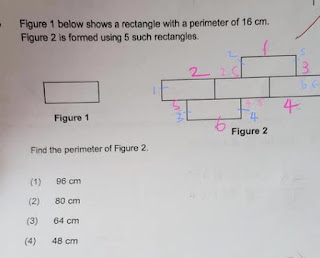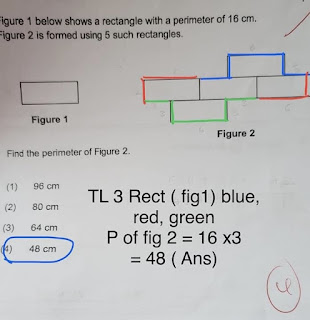On Facebook, someone recently posted the above primary 4 (or grade 4) geometry question, asking for help from fellow parents. How would you do it (without calling on ChatGPT)?
If you’re a parent, homeschooler, or tutor, how would you explain it to an eight- or nine-year-old child, who’s struggling with non-drill-and-kill questions on area and perimeter?
Try figuring out the answer on your own first before peeping at two parents’ quick-and-dirty solutions below. Better still, could you present an idiot-proof or peasant-friendly solution that even a smart dog or cat could understand?
6 width and 6 long = 3units of the rectangle.
1 rectangle -> 16cm.
3 rectangle
16x3 = 48cm.
Many moons ago, I was commissioned to write Mind Stretchers 2*, a grade 5 problem-solving math book, which was popular in a number of local schools and tuition centers—disturbingly, they’re guiltlessly or blatantly photostating entire chapter questions as part of their worksheets.
And I still recall that on the topic of Perimeter, I’d posed a number of routine and nonroutine questions. What surprised or tickled me then was when the Managing Editor asked me whether or not some of these questions are solvable, because at first glance, they look like there are missing information to solving them.
These geometry questions can give students (and probably their oft-math-anxious parents and teachers) some goose pimples out of fear or panic if they can’t figure out the answers offhand.
Understandably, without a cool mind and some patience (or perseverance), even perimeter and area questions at the elementary (or olympiad) level can prove to be a challenge to math educators if they’re not trained to tackling them using the right approach.
Frustration and fear usually set in, especially for nonroutine questions that don’t normally appear in drill-and-kill school textbooks and workbooks.
The danger of setting these types of brain-unfriendly questions too early, or having them prematurely in a class test, especially when most students have yet to fully grasp the concepts of area and perimeter, could be detrimental to the mental health of most average math students.
Parents who freeze at the sight of these questions would often exhibit a knee-jerk reaction, by getting a tutor for their child, if they’d afford it.
Most stressed parents often reason that if they couldn’t even solve these grade 4 questions, things would only get worse in later years, as the higher-grade topics get more complicated and the questions become more challenging. They just don’t want to see their child struggle in math, especially when they themselves had had a negative experience of the world’s most disliked school subject.
Even for math teachers and tutors, there’s nothing to be ashamed of if at first or second reading, they’re clueless how to tackle these nonroutines. Yes, they do appear in mid- or final-year exams arguably as a social filter to separate the nerd from the herd, but once math educators and homeschoolers know how to approach these questions from the right angle, before long, these math problems would become routine to them.
Few math teachers and writers would admit that (school or olympiad) math involves lots of fears, false starts, frustrations, and failures. The sooner parents and homeschoolers (and their children and grandchildren) are aware of this oft-unspoken problem-solving process or ritual, the pressure or expectation level for all parties ought to go down significantly in reducing any unnecessary mental or mathematical stress.
Pain is (always) part of the joy of creative mathematical problem solving—the no-pain-no-gain mantra is axiomatic in math at all levels.
Geometrically & perseveringly yours
© Yan Kow Cheong, October 16, 2023.
* When the wallet-friendly title was out of print, a senior editorial staff emailed me that he’d pay me a cosmetic S$150 to buy the copyrights. I never bothered to reply to his laughably ridiculous suggestion. I wouldn’t be surprised that they’d since plagiarized the content to be used and reused for other purposes.



